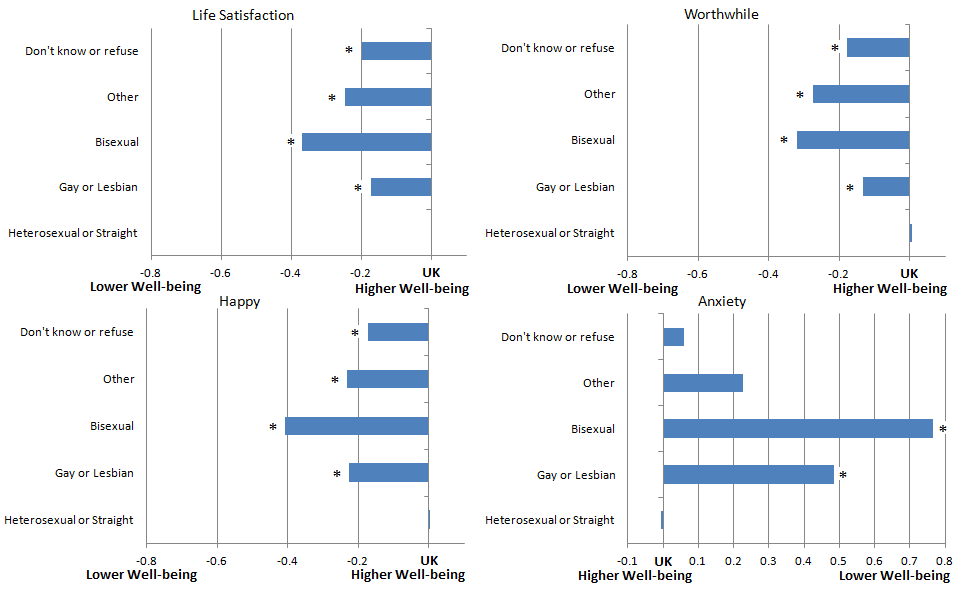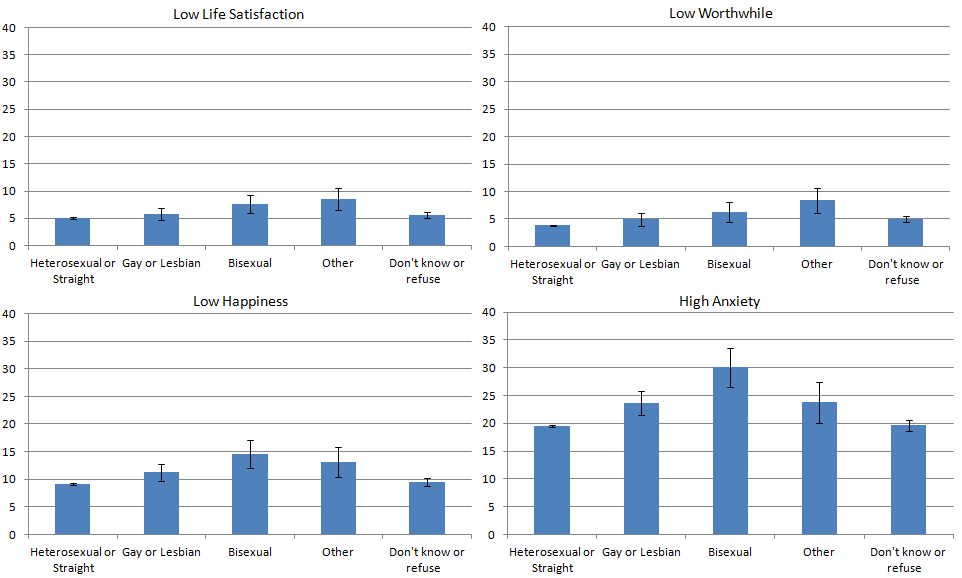1. Main finding
Those who identify as gay or lesbian, or bisexual report lower well-being than the UK average for all personal well-being measures. This difference is largest for feelings of anxiety.
Nôl i'r tabl cynnwys2. Things you need to know about this release
This release examines how personal well-being ratings vary dependent on a person’s sexual identity. Sexual identity is one part of the umbrella concept of sexual orientation, a recognised protected characteristic under the Equality Act (2010). Sexual identity does not necessarily reflect sexual attraction or sexual behaviour – these are separate concepts, which we currently do not measure.
For information on the measurement of personal well-being and sexual identity please see the Quality and methodology section of this release.
The Equality Act (2010) lists the following as protected characteristics, and our accompanying dataset provides personal well-being statistics broken down by 7 of these:
age
disability
gender reassignment (data not available in this release)
marriage and civil partnership
pregnancy and maternity (data not available in this release)
race
religion or belief
sex
sexual orientation
Personal well-being statistics are designated as National Statistics, having been assessed against the Code of Practice for Official Statistics in accordance with the Statistics and Registration Service Act 2007. However, sexual identity estimates have not been assessed in this way and should therefore be treated as Experimental Statistics. Whilst this publication has been badged as a National Statistic, you should apply caution in interpreting estimates of sexual identity in this release.
These are estimates from the Annual Population Survey (APS) 3-year dataset. This dataset allows for more granular analysis of personal well-being, however, currently it does not allow for over time comparisons. For more timely estimates and comparisons over time, please see the rolling annual estimates of personal well-being.
This is the first time that the 3-year dataset has been created on a calendar year basis (January to December). The previous two have been created on a financial year basis (April to March).
We welcome feedback on these changes. Please contact the Quality of Life team (QualityOfLife@ons.gov.uk) with any comments or suggestions, including your views on improvements we might make.
Nôl i'r tabl cynnwys3. Average ratings highest for those identifying as heterosexual or straight
Figure 1 presents average personal well-being ratings broken down by self-reported sexual identity. Those who identify as heterosexual or straight tended to report the highest average levels of well-being across all four measures of personal well-being.
Figure 1: Personal well-being by self-reported sexual identity, 3 years ending December 2015
UK

Source: Annual Population Survey, Office for National Statistics
Notes:
- Axis does not start at 0.
- 'Other' means that the respondent did not consider themselves to fit into the heterosexual or straight, bisexual, gay or lesbian categories.
- Unit: Mean (average)
Download this image Figure 1: Personal well-being by self-reported sexual identity, 3 years ending December 2015
.png (20.4 kB) .xls (21.0 kB)Figure 2 illustrates how average personal well-being ratings by self-reported sexual identity compare with the UK average rating. Those who identify themselves as gay or lesbian, or bisexual report lower well-being than the UK average for all personal well-being questions. Those who identify themselves as “other” or “do not know or refuse” report lower life satisfaction, worthwhile and happiness than the UK average.
Figure 2: Difference in personal well-being ratings by self-reported sexual identity compared with UK average, 3 years ending December 2015
UK

Source: Annual Population Survey, Office for National Statistics
Notes:
- A * denotes statistically significant difference from UK average.
- 'Other' means that the respondent did not consider themselves to fit into the heterosexual or straight, bisexual, gay or lesbian categories.
Download this image Figure 2: Difference in personal well-being ratings by self-reported sexual identity compared with UK average, 3 years ending December 2015
.png (21.8 kB) .xls (29.2 kB)4. Differences between sexual identities largest for anxiety
The largest differences in personal well-being between self-reported sexual identities, for both means and thresholds, were seen in anxiety. The largest difference was seen for those reporting high anxiety (those answering 6 to 10 out of 10).
Three in every ten people (30.1%) who identify themselves as bisexual reported their anxiety as high (answering 6 to 10 out of 10). This compares with two in every ten people (19.5%) who identify themselves as heterosexual or straight (see Figure 3).
Figure 3: Percentage reporting low life satisfaction, worthwhile and happiness, and high anxiety by self-reported sexual identity, 3 years ending December 2015
UK

Source: Annual Population Survey, Office for National Statistics
Notes:
- 'Other' means that the respondent did not consider themselves to fit into the heterosexual or straight, bisexual, gay or lesbian categories.
- Unit: %
Download this image Figure 3: Percentage reporting low life satisfaction, worthwhile and happiness, and high anxiety by self-reported sexual identity, 3 years ending December 2015
.png (19.2 kB) .xls (21.0 kB)5. What factors may explain these results?
Previous research has identified that general health, employment and relationship status have the largest association with personal well-being. Relating to this, potential factors influencing the results presented in this release could include health outcomes, discrimination in access to services (including health services) and in the workplace (Albuquerque etc al., 2014; Welsh government, 2014; Hudson-Sharp and Metcalf, 2016; Stonewall 2013; Stonewall).
It must also be recognised that these estimates do not account for other potential factors which may influence well-being ratings. The release Sexual Identity, UK: 2015 showed that you are more likely to report identifying as lesbian, gay or bisexual if you live in London and previous research has shown that personal well-being is generally lower in London.
This is the first time that we have produced estimates of personal well-being by sexual identity. This analysis provides initial insight looking at personal well-being and sexual identity, we hope to build upon this work going forwards.
Nôl i'r tabl cynnwys7. Quality and methodology
The Personal Well-being in the UK Quality and Methodology Information document and Sexual identity Quality and Methodology Information document contain important information on:
- the strengths and limitations of the data
- the quality of the output: including the accuracy of the data and how it compares with related data
- uses and users
- how the output was created
How we measure personal well-being
Since 2011, we have asked personal well-being questions to adults in the UK, to better understand how they feel about their lives. This release presents estimates of personal well-being for the 3 years ending December 2015.
The four personal well-being questions are:
- overall, how satisfied are you with your life nowadays?
- overall, to what extent do you feel the things you do in your life are worthwhile?
- overall, how happy did you feel yesterday?
- overall, how anxious did you feel yesterday?
People are asked to respond on a scale of 0 to 10, where 0 is “not at all” and 10 is “completely”. We produce estimates of the mean ratings for all four personal well-being questions, as well as their distributions, using the thresholds.
For more information on personal well-being please see the Personal Well-being user guide.
Table 1: Labelling of thresholds
Life satisfaction, worthwhile and happiness scores Anxiety scores Response on an 11 point scale Label Response on an 11 point scale Label 0 to 4 Low 0 to 1 Very low 5 to 6 Medium 2 to 3 Low 7 to 8 High 4 to 5 Medium 9 to 10 Very high 6 to 10 High Source: Office for National Statistics Download this table Table 1: Labelling of thresholds
.xls (26.6 kB)All the differences noted in the text are statistically significant. The statistical significance of differences are approximate because they are determined on the basis of non-overlapping confidence intervals. This method provides a conservative estimate of statistical significance, which may result in estimates that are statistically significantly different to one another being assessed as not.
The results are not the outcome of regression analysis, trying to hold all other characteristics (for example, age) equal. Results therefore do not tell us how important self-reported sexual identity matters to well-being ratings compared against other factors.
This analysis is based on the Annual Population Survey 3-year dataset covering the period January 2013 to December 2015. This dataset covers the population over the age of 16 living in private households and contains around 300,000 unique responses to the personal well-being questions.
The sexual identity question is asked of respondents aged 16 years and over; it is not asked by proxy. Proxy interviews are defined as those where answers are supplied by a third party, who is usually a member of the respondent’s household.
The sexual identity question is asked in both face-to-face and telephone interviews, at first personal contact. During the face-to-face interviews, adults were asked: "Which of the options on this show card best describes how you think of yourself?" For telephone interviews, a slightly different way of collecting the information was used: "I will now read out a list of terms people sometimes use to describe how they think of themselves". The list is read out to respondents twice. On the second reading, the respondent has to say "stop" when an appropriate term they identified with is read out. In both modes, the order in which the terms appeared, or are read out, is unique for each household’s respondent to ensure confidentiality. The "Other" option on the question is included to address the fact that not all people will consider they fall in the first three categories, that is, heterosexual or straight, gay or lesbian, or bisexual.
Why is this release not LGBT?
T stands for Transgender or Trans, which are umbrella terms used to refer to people whose Gender Identity differs from what is typically associated with their assigned sex at birth.
Although gender and sexual identity are related, the focus of this publication is Sexual Identity not Gender Identity. Your Gender Identity is how you identify and present yourself at a point in time, your Sexual Identity is a subjective view of yourself which may change over time, in different contexts and may differ from sexual attraction and behaviour.

